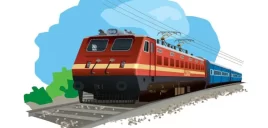IR provides generous amounts of make-up time or slack (also known as Extra Time Allowed (marked ‘EA’ in the working timetable), or margin) in the schedules for most long-distance trains. Delays of half-an-hour to a couple of hours are almost inevitable in the running of most long-distance trains (except the ‘prestigious’ ones such as the Rajdhanis or Shatabdis, which are generally given great operational priority), and with good luck, the slack in the later portions of the journey will allow the train to make its destination on time. EA is specifically intended to account for delays caused by caution orders and track conditions, and any delays attributable to the train’s running itself (alarm chain pulling, late departure from a station, etc.) A further category of make-up time called Traffic Recovery Time (marked ‘TRT’) is also provided to allow for delays due to line and block section occupancy in heavy traffic. Finally there is Make-up Allowance, which is not a real make-up time but a reference amount calculated as the difference in time the train takes to cover a section at booked speed vs. at maximum permissible speed.
As an example of the make-up time often worked into train schedules, the 6km stretch between Perambur and Chennai stations is usually allocated a running time of 40 to 45 minutes for trains such as the Bangalore Mail, Kaveri Exp., etc. The Cheran Exp. in 2006 had 60 minutes allocated in the timetable for this stretch.
Note also that mail/superfast/express trains are generally also given priority over passenger trains, especially if the faster train is running late. Recovery time for a train is usually allotted to the final section of the train’s run within a railway division. Thus, for trains that start or end close to a divisional boundary, the difference in scheduled trip time for the up and down journeys can be substantial.
The working timetables usually provide a breakdown of the working time durations for each train on a section. A typical analysis for a train may be as follows:
Difference between minimum running time
and normal running time |
6 minutes |
| Recovery time |
2 minutes |
| Loss of time for passenger |
4 minutes |
| Total |
12 minutes |
| Extra time actually allowed |
10 minutes |
Source – IFRCA.org
Disclaimer: The Information /News /Video provided in this Platform has been collected from different sources. We Believe that “Knowledge Is Power” and our aim is to create general awareness among people and make them powerful through easily accessible Information. NOTE: We do not take any responsibility of authenticity of Information/News/Videos.
This entry was posted in 2 Railway Employee, STUDY NEW, Railway Employee











